check engine CHEVROLET TRACKER 1996 Owner's Manual
[x] Cancel search | Manufacturer: CHEVROLET, Model Year: 1996, Model line: TRACKER, Model: CHEVROLET TRACKER 1996Pages: 387, PDF Size: 18.54 MB
Page 247 of 387
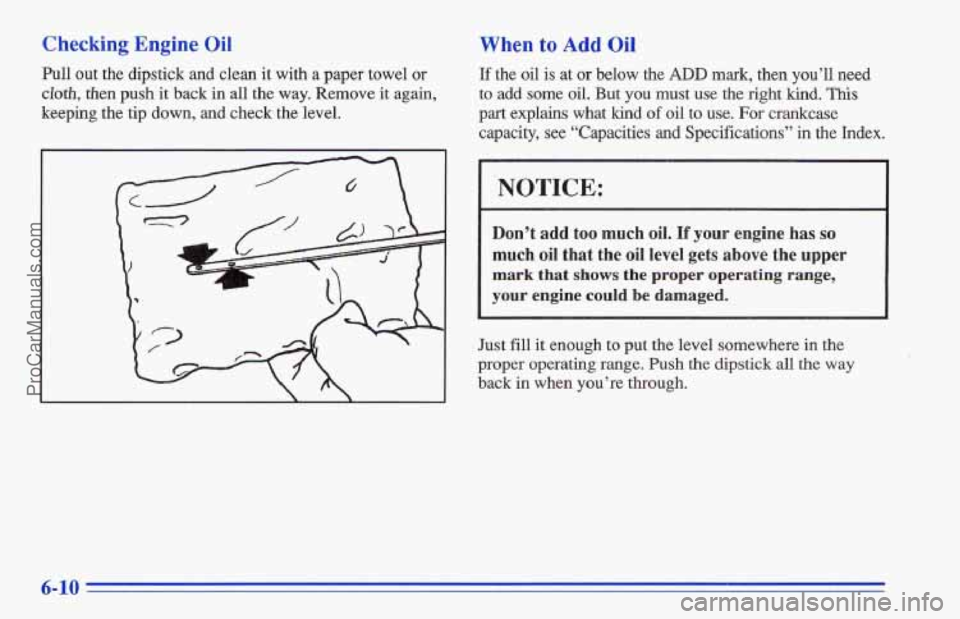
Checking Engine Oil
Pull out the dipstick and clean it with a paper towel or
iApBrh, then push it back in all the way. Remove it again,
keeping the tip down, and check the level.
When to Add Oil
If the oil is at or below the ADD mark, then you’ll need
to
add some oil. But you must use the right kind. This
part explains what kind of oil to use. For crankcase
capacity, see “Capacities
and Specifications” in the Index.
NOTICE:
Don’t add too much oil. If your engine has so
much oil that the oil level gets above the upper
mark that shows the proper operating range,
your engine could be damaged.
Just fill it enough to put the level somewhere in the
proper operating range. Push the dipstick all the way
back in when you’re through.
ProCarManuals.com
Page 251 of 387
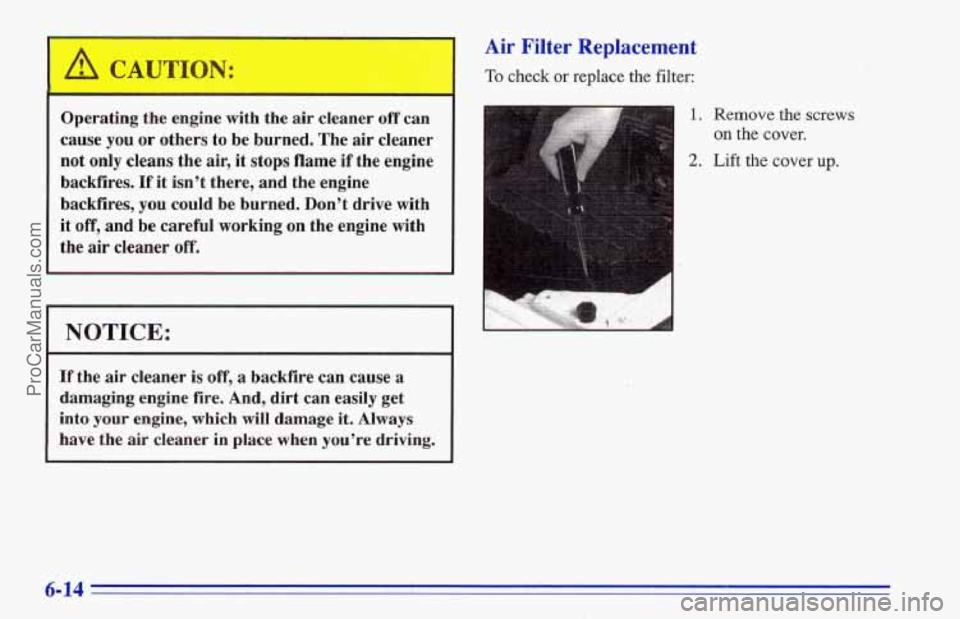
~ Operating the
engine with the air cleaner off can
~ cause you or others to be burned. The air cleaner
~ not only cleans the air, it stops flame if the engine
backfires.
If it isn’t there, and the engine
backfires,
you could be burned. Don’t drive with
it
off, and be careful working on the engine with
the air cleaner off.
I NOTICE:
If the air cleaner is off, a backfire can cause a
damaging engine fire. And, dirt can easily get
into your
engine, which will damage it. Always
have the
air cleaner in place when you’re driving.
Air Filter Replacement
To check or replace the filter:
F
1.
2.
Remove the screws
on the cover.
Lift the cover up.
6-14
ProCarManuals.com
Page 252 of 387
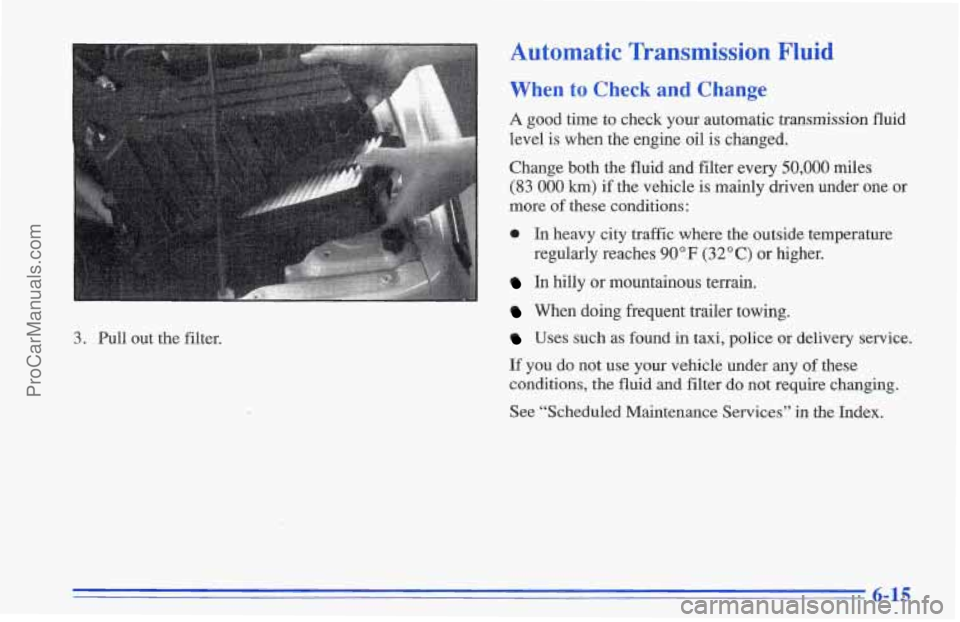
3. Pull out the filter.
Automatic Transmission Fluid
When to Check and Change
A good time to check your automatic transmission fluid
level is when the engine oil is changed.
Change both the fluid and filter every
50,000 miles
(83 000 km) if the vehicle is mainly driven under one or
more of these conditions:
0 In heavy city traffic where the outside temperature
regularly reaches
90°F (32” C) or higher.
In hilly or mountainous terrain.
When doing frequent trailer towing.
Uses such as found in taxi, police or delivery service.
If you do not use your vehicle under any of these
conditions, the fluid and filter do not
require changing.
See “Scheduled Maintenance Services” in the Index.
6-15
ProCarManuals.com
Page 253 of 387
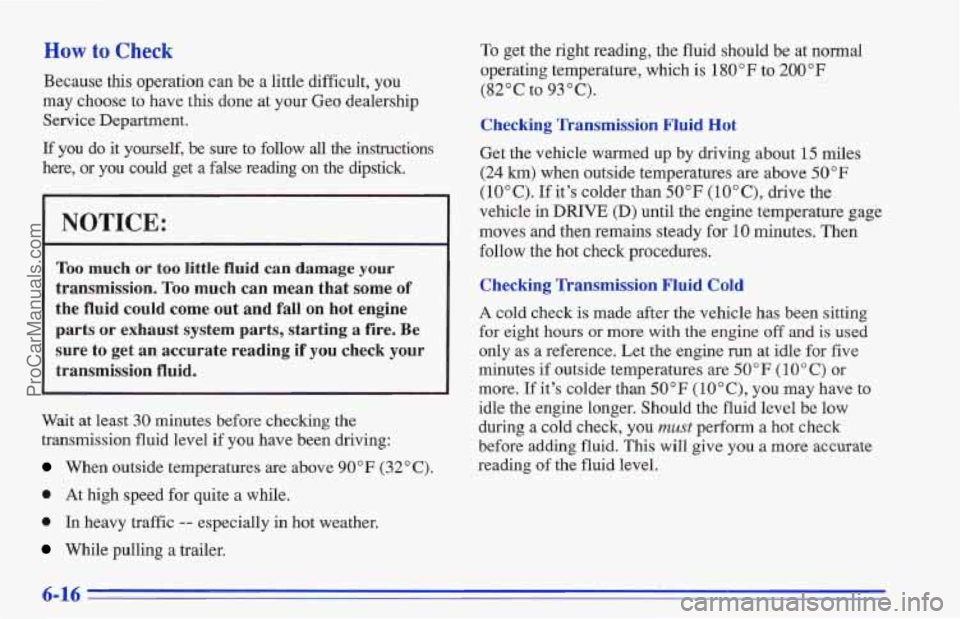
How to Check
Because this operation can be a little difficult, you
may choose to have t,his done at
your Geo dealership
Service Department.
If you do it yourself, be sure to follow all the instructions
here, or
you could get a false reading on the dipstick.
NOTICE:
Too much or too little fluid can damage your
transmission. Too much can mean that some of
the fluid could come out and fall on hot engine
parts
or exhaust system parts, starting a fire. Be
sure to get an accurate reading if you check your
transmission fluid.
Wait at least 30 minutes before checking the
transmission fluid level if you have been driving:
When outside temperatures are above 90°F (32°C).
At high speed for quite a while.
@ In heavy traffic -- especially in hot weather.
While pulling a trailer.
To get the right reading, the fluid should be at normal
operating temperature, which
is 180°F to 200 "F
(82°C to 93°C).
Checking Transmission Fluid Hot
Get the vehicle warmed up by driving about 15 miles
(24 km) when outside temperatures are above 50°F
(10°C). If it's colder than 50°F (lO"C), drive the
vehicle
in DRIVE (D) until the engine temperature gage
moves and then remains steady for
10 minutes. Then
follow the hot check procedures.
Checking Transmission Fluid Cold
A cold check is made after the vehicle has been sitting
for eight hours or more with the engine off and is used
only
as a reference. Let the engine run at idle for five
minutes
if outside temperatures are 50 "F (10" C) or
more.
If it's colder than 50°F (lO°C), you may have to
idle the engine longer. Should the fluid level be low
during
a cold check, you must perform a hot check
before adding fluid. This will give
vou a more accurate
reading of the fluid level.
6-16
ProCarManuals.com
Page 254 of 387
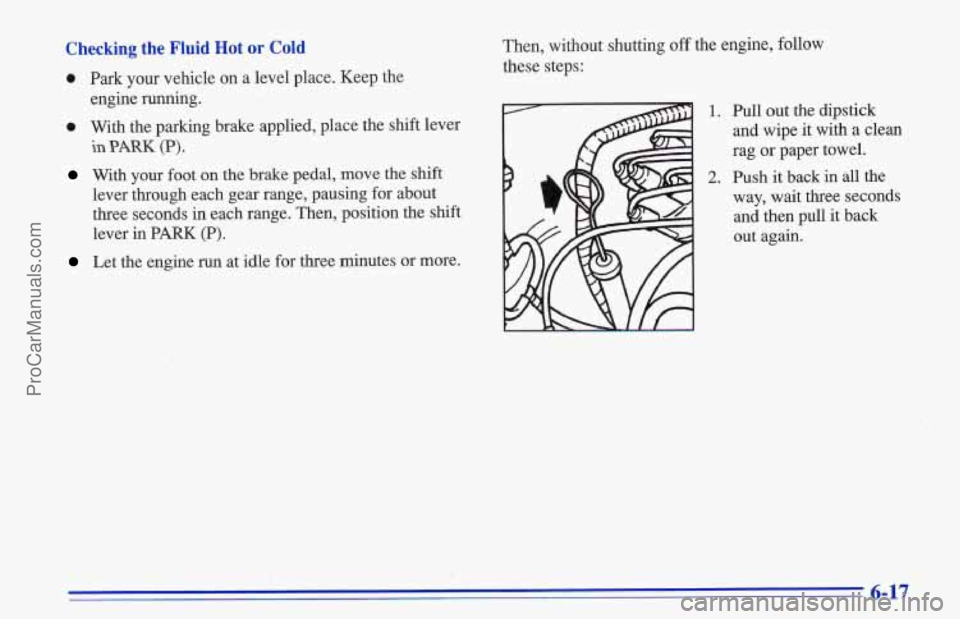
Checking the Fluid Hot or Cold
0 Park your vehicle on a level place. Keep the
engine running.
0 With the parking brake applied, place the shift lever
in PARK (P).
With your foot on the brake pedal, move the shift
lever through each gear range, pausing for about
three seconds
in each range. Then, position the shift
lever
in PARK (P).
Let the engine run at idle for three minutes or more. Then,
without shutting
off the engine, follow
these steps:
1.
2.
Pull out the dipstick
and wipe it with
a clean
rag or paper towel.
Push it back
in all the
way, wait three seconds
and then pull it back
out again.
6-17
ProCarManuals.com
Page 256 of 387
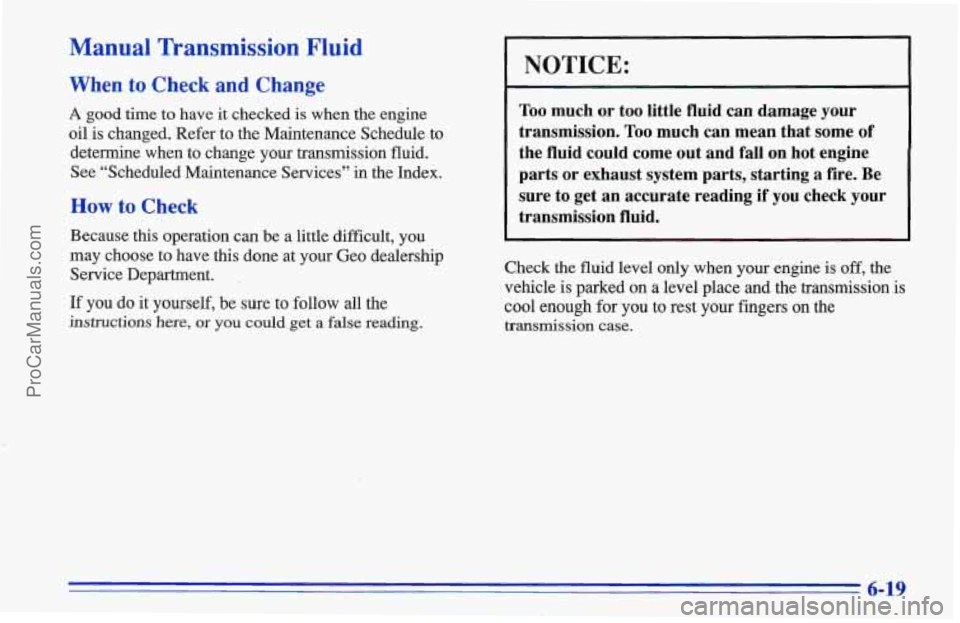
Manual Transmission Fluid
When to Check and Change
A good time to have it checked is when the engine
oil is changed. Refer to the Maintenance Schedule to
determine when to change your transmission fluid.
See “Scheduled Maintenance Services” in the Index.
How to Check
Because this operation can be a little difficult, you
may choose to have this done at your Geo dealership
Service Department.
If you do it yourself, be sure to follow all the
instructions
here, or you could get a false reading.
NOTICE:
Too much or too little fluid can damage your
transmission.
Too much can mean that some of
the fluid could come out and fall on hot engine parts or exhaust system parts, starting
a fire. Be
sure to get an accurate reading if
you check your
transmission fluid.
Check the fluid level only when your engine is off, the
vehicle is parked on a level place and the transmission is
cool enough for
you to rest your fingers on the
transmission case.
6-19
ProCarManuals.com
Page 262 of 387
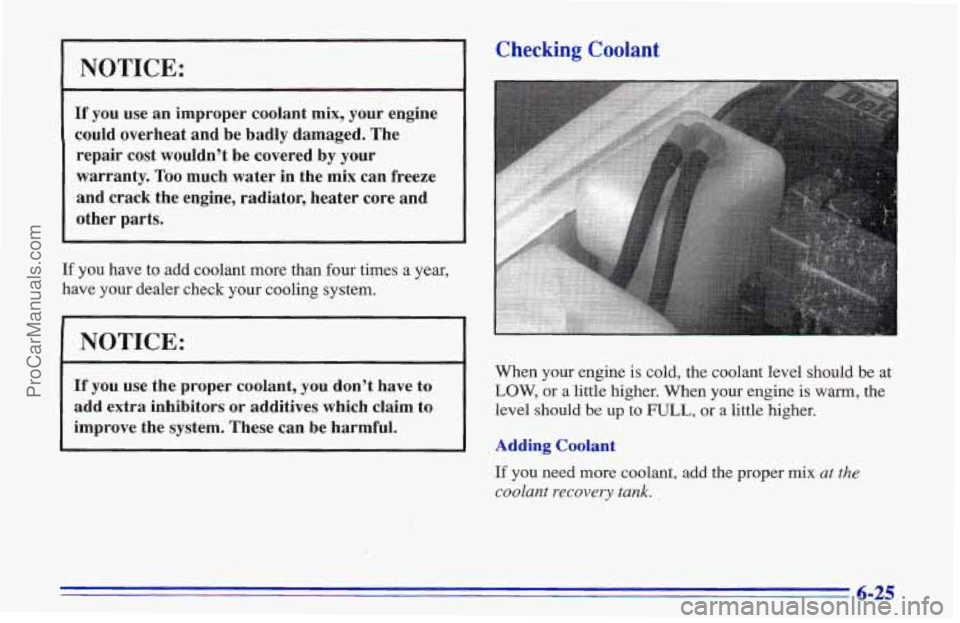
NOTICE:
If you use an improper coolant mix, your engine
could overheat and be badly damaged. The
repair cost wouldn’t be covered by
your
warranty. Too much water in the mix can freeze
and crack the engine, radiator, heater core and
other parts.
If you have to add coolant more than four times a year,
have your dealer check your cooling system.
NOTICE:
r
If you use the proper coolant, you don’t have to
add extra inhibitors or additives which claim to
improve the system. These can be harmful.
Checking Coolant
When your engine is cold, the coolant level should be at
LOW, or
a little higher. When your engine is warm, the
level should be
up to FULL, or a little higher.
Adding Coolant
If you need more coolant, add the proper mix at the
coolant recovery tank.
6-25
ProCarManuals.com
Page 264 of 387
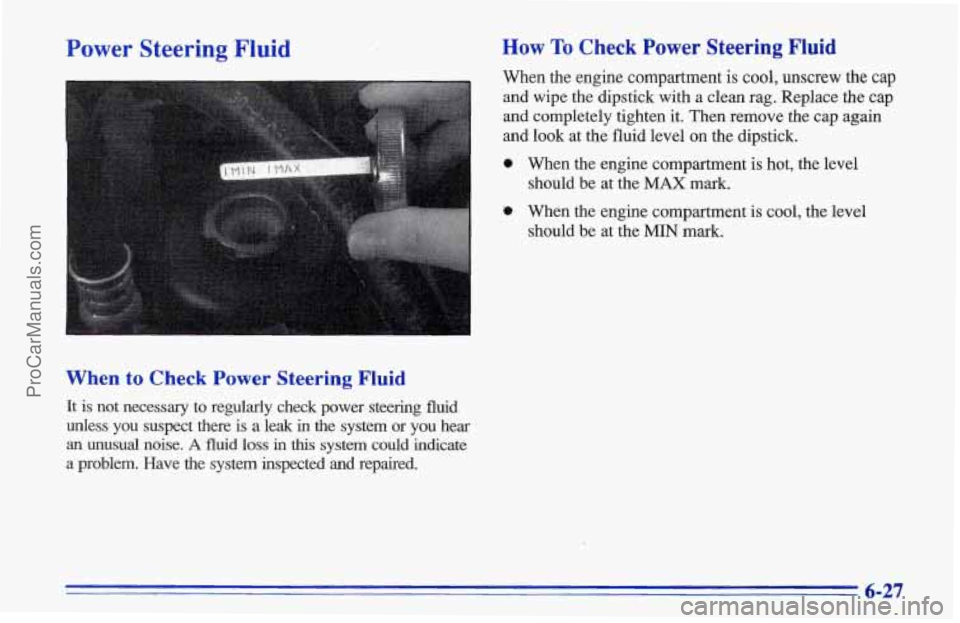
Power Steering Fluid
When to Check Power Steering Fluid
It is not necessary to regularly check power steering fluid
unless you suspect there
is a leak in the system or you hear
an unusual noise. A fluid loss in this system could indicate
a problem. Have the system inspected and repaired.
How To Check Power Steering Fluid
When the engine compartment is cool, unscrew the cap
and wipe the dipstick with a clean rag. Replace the cap
and completely tighten it. Then remove the cap again
and look at the fluid level on the dipstick.
0 When the engine compartment is hot, the level
@ When the engine compartment is cool, the level
should
be at the
MAX mark.
should be at the
MIN mark.
6-27
ProCarManuals.com
Page 267 of 387
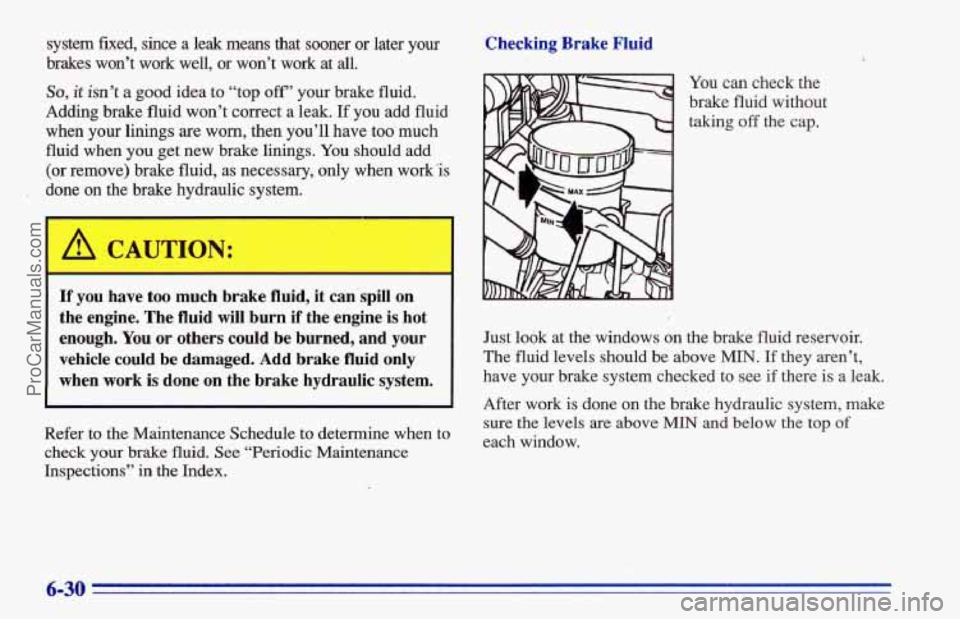
system fixed, since a leak means that sooner or later your
brakes won’t work well, or won’t work at all.
So, it isn’t a good idea to “top off’ your brake fluid.
Adding brake fluid won’t correct a leak.
If you add fluid
when your linings
are worn, then you’ll have too much
fluid when
you get new brake linings. You should add
(or remove) brake fluid, as necessary, only when work ’is
done on the brake hydraulic system.
A CAUTION:
If you have too much brake fluid, it can spill on
the engine. The fluid will burn if the engine is hot
enough.
You or others could be burned, and your
vehicle could be damaged. Add brake fluid only
when work
is done on the brake hydraulic system.
Refer to the Maintenance Schedule to determine when to
check your brake fluid. See “Periodic Maintenance
Inspections” in the Index.
Checking Brake Fluid
You can check the
brake fluid without taking
off the cap.
Just look at the windows on the brake fluid reservoir.
The fluid levels should be above
MIN, If they aren’t,
have your brake system checked
to see if there is a leak.
After work is done on the brake hydraulic system, make
sure the levels
are above MIN and below the top of
each window.
ProCarManuals.com
Page 294 of 387
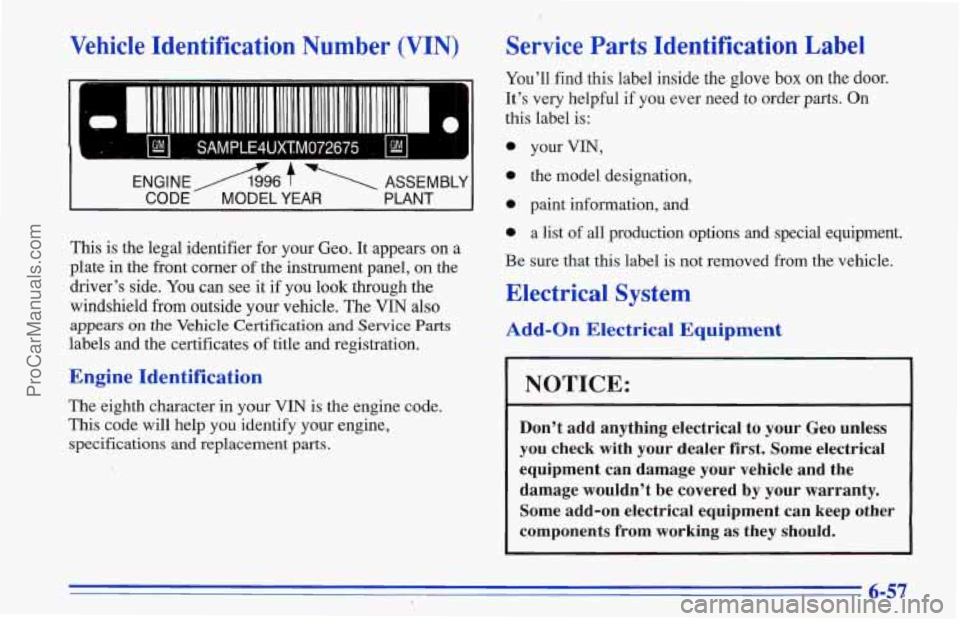
Vehicle Identification Number (VIN)
- - ..
c
I. ’ m. SAMPLE4UXTM072675 . 1
ENGINEAG $. ASSEMBLY
-
CODE MODEL YEAR PLANT
This is the legal identifier for your Geo. It appears on a
plate
in the front corner of the instrument panel, on the
driver’s side. You can see it
if you look through the
windshield
from outside your vehicle. The VIN also
appears
on the Vehicle Certification and Service Parts
labels and the certificates of title and registration.
Engine Identification
The eighth character in your VIN is the engine code.
This code will help
you identify your engine,
specifications and replacement parts.
Service Parts Identification Label
You’ll find this label inside the glove box on the door.
It’s very helpful if you ever need to order parts. On
this label is:
0
0
0
0
your VIN,
the model designation,
paint information, and
a list
of all production options and special equipment.
Be sure that this label is not removed from the vehicle.
Electrical System
Add-on Electrical Equipment
NOTICE:
Don’t add anything electrical to your Geo unless
you check with your dealer first. Some electrical
equipment can damage your vehicle and the
damage wouldn’t be covered by your warranty.
Some add-on electrical equipment can keep other
components from working
as they should.
6-57
ProCarManuals.com